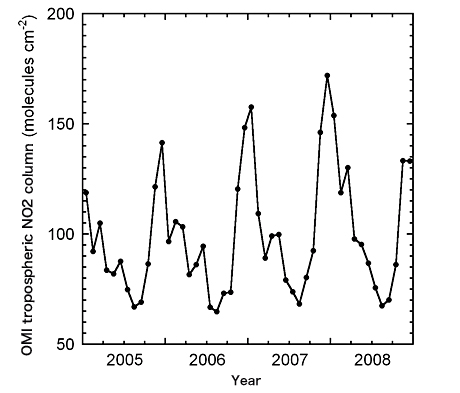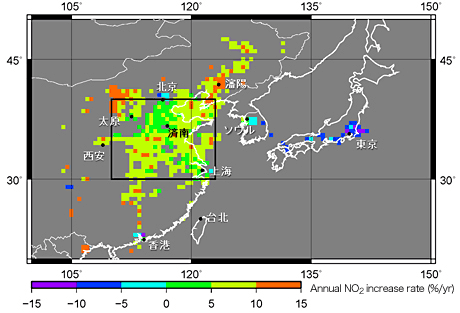
August 7, 2009
Japan Agency for Marine-Earth Science and Technology
Atmospheric NO2 levels in China Reach Record High in 2007 and 2008
- Continuous Increase Since 1996 May Be Affecting Air Quality in Japan -
1. Overview
Tropospheric nitrogen dioxide (NO2 ) concentration in China has been increasing since 1996 and reached a record high in the period from 2007 to 2008, Hitoshi Irie and his colleagues from the Environmental Biogeochemical Cycle Research Program of the Research Institute for Global Change (RIGC), Japan Agency for Marine-Earth Science and Technology (JAMSTEC: Yasuhiro Kato), have revealed for the first time in a study using satellite data from the Ozone Monitoring Instrument (OMI, *1)(Fig. 1).
The analysis of the OMI data from recent years (from 2005 to 2008) also portrayed areas with a rapid increase in tropospheric NO2 , compared with Beijing and its surroundings (Fig. 2). This trend highlights the need to implement air-pollution control measures not only in specific industrial areas but also in other areas across China. During the same period, an increase in photochemical oxidants (*2) was observed all around Japan, where the NO2 concentrations remained unchanged or showed a decreasing trend (Fig. 2). This phenomenon suggests the effect of air pollutants transported into the skies over Japan, indicating the need for urgent measures against air pollution across borders.
The study was supported by the Global Environmental Research Fund of the Ministry of the Environment, “Study on promotion of atmospheric environment management considering co-benefit for better understanding of wide-area atmospheric pollution in East Asia and global warming measures”, as well as the Japan EOS (Earth Observation System) Promotion Program of the Ministry of Education, Culture, Sports, Science and Technology (MEXT), “Development of a network for simultaneous observation of tropospheric gases and aerosols by a ground-based spectroscopic method.”
The paper on this study will be published online on August 8th in the Scientific Online Letters on the Atmosphere, a English newsletter issued by the Japan Meteorological Agency.
Title: Characterization of OMI tropospheric NO2 measurements in East Asia based on a robust validation comparison
Author: Hitoshi Irie, Yugo Kanaya, Hisahiro Takashima, James F. Gleason, and Zifa Wang
2. Background
In recent years, elevated concentrations of atmospheric oxidants have been reported in Japan. In May 2007, in particular, warnings on high concentrations of photochemical oxidants were issued for the first time in Nagasaki, Oita and Niigata prefectures. One of the primary causes of the recent elevated concentration is thought to be an increase in tropospheric nitrogen oxides over China, located on the windward side of Japan. As in the fight against global warming, the abatement of such trans-boundary air pollution cannot be addressed by a single nation. However, the temporal changes and geographical distribution of atmospheric NO2 concentration in China have not yet been clearly understood. To this end, and in order to investigate the location and magnitude of such changes in atmospheric environment, the team analyzed high-spatial resolution images of OMI tropospheric data.
3. Outline of Methods
The high-resolution OMI dataset between 2005 and 2008 was examined and validated using ground-based remote sensing data obtained from the MAX-DOAS measurements (*3). The validated datasets were then used to estimate NO2 concentrations for 0.5-degree grid cells (approximately 50 km) bounded by latitudinal/longitudinal lines.
4. Results and Discussion
The analyses of the OMI NO2 data between 2005 and 2008 revealed rapid increases in NO2 concentration over the North China Plain in eastern China, at a rate of 5% per year (Figure 2). The data obtained from other satellite sensors, GOME (*4) and SCIAMACHY (*5), also showed the increase in this area before 2005, suggesting the continued rise in atmospheric NO2 concentration for more than ten years.
In addition, the geographical distribution of the NO2 increase between 2005 and 2008, revealed areas with a particularly higher increase rate, compared to those in Beijing and its surroundings. Some of these areas showed an annual increase rate of 10 to 15% (e.g. Shenyang) (Fig. 2).
The above evidence indicates the need for addressing air pollution not only in specific industrial areas but also in other areas in China. Meanwhile, during the same period in Japan, the atmospheric NO2 level remained unchanged or showed a decreasing trend, despite a nationwide increase in photochemical oxidants, the products of sunlight-induced reactions between NO2 and organic compounds. The discrepancy between the trends in these air quality indicators implies the effect of trans-boundary pollutants, suggesting the need for international cooperation to reduce air pollution.
5. Future perspectives
As shown in this study, when a higher concentration of photochemical oxidants was observed in Japan, the tropospheric NO2 concentration was also found to be increasing in China. This phenomenon is expected to help raise public awareness about the trans-boundary air pollution, and aid in formulating international strategies to reverse the degradation of air quality.
The team will continue analyzing the OMI data, focusing on the impact of changes in future economic activities on atmospheric environment. The findings are expected to further advance atmospheric studies, which in turn will lead to the establishment of a continuous surveillance system to monitor the atmospheric environment.
*1. Ozone Monitoring Instrument (OMI) is a nadir viewing imaging spectrometer aboard NASA’s satellite Aura, launched in 2004. It is operated by the Netherlands, Finland and the United States and is capable of retrieving the vertical column density of air pollutants, including NO2 , from spectra of surface and atmospheric backscattered sunlight in the visible and ultraviolet range. The nominal spatial resolution is 13 km × 24 km (at nadir).
*2. Photochemical oxidants are the products of photochemical reactions between nitrogen oxides and volatile organic compounds in the air. The most well-known oxidant is ozone.
*3. Multi-Axis Differential Optical Absorption Spectroscopy (MAX-DOAS) is a method to measure tropospheric trace gases and aerosols, using a conventional passive DOAS device coupled with functions to measure at different low elevation angles. The DOAS system usually employs an ultraviolet/visible spectrometer.
*4. Global Ozone Monitoring Experiment (GOME) is a spectrometer launched aboard ERS-2 (European Remote Sensing satellite-2) in 1995. It measures the spectra of ultraviolet/visible sunlight reflected at the Earth’s surface, thereby providing the vertical column density of atmospheric pollution gasses including NO2, sulfur dioxide (SO2), ozone (O3), bromine monoxide (BrO), and formic acid (H2CO).The nominal spatial resolution is 40km (latitude) and 320 km (longitude).
*5. SCanning Imaging Absorption SpectroMeter for Atmospheric
CHartographY (SCIAMACHY) is an imaging spectrometer aboard ENVISAT, the European earth-observing satellite launched in 2001. It works on the similar principle to GOME, but has a higher spatial resolution and coverage, allowing for the measurement of a wide variety of chemical compounds including the following:
Ozone(O3), bromine monoxide(BrO), chlorine dioxide(OClO), chlorine
oxide(ClO), sulfur oxide(SO2),
formic acid (H2CO),
nitrogen dioxide(NO2), carbon monoxide(CO), carbon dioxide(CO2),
methane(CH4), water vapor(H2O), and nitrous oxide(N2O).
- Figure 1: Monthly mean NO2 concentration in the North China Plain (area bounded by a rectangle in Figure 2)

-
Figure 2: Geographical distribution of OMI tropospheric NO2 increase for 2005–2008.
Values were calculated for a grid of 0.5º ×0.5º latitude and longitude. The average NO2 increase in an area bounded by a rectangle was 5% per year.

Contacts:
- Japan Agency for Marine-Earth Science and Technology
(For the study) -
Hitoshi Irie
Atmospheric Composition Observational Research Team
Environmental Biogeochemical Cycle Research Program
Research Institute for Global Change (RIGC)
- (For Publication)
-
Toru Nakamura, e-mail: press@jamstec.go.jp
Manager, Planning Department Press Office